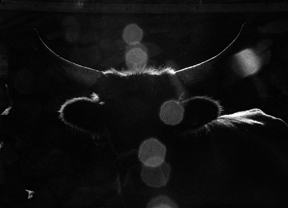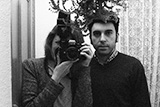Her Name Was Europa
 GERMANY / 2020 / English / Color, B&W / DCP/ 76 min
GERMANY / 2020 / English / Color, B&W / DCP/ 76 min
Directors, Photography, Editing, Script: Anja Dornieden, Juan David González Monroy
Sound Editor: Christian Obermaier
Producer, Source: OJOBOCA GbR www.ojoboca.com
The aurochs was a wild breed of cow, ancestor of the domesticated animal we know today, that went extinct in the 17th century. Efforts to revive the aurochs through crossbreeding have been attempted since the 20th century and the animals continue to be regarded as a symbol of strength, agility, and bravery. Following the writings of animal scientist Lutz Heck, who conducted research into reviving the aurochs in Germany during the 1920s, the film looks into new crossbreeding experiments of today and the results of recent genetic research. Expanding on the image of the lost species through media such as paintings and sculpture, the directors set out to retell the myth of Europa—tempted by Zeus, masquerading as a white ox—yet somehow things don’t go quite as they planned.
[Director’s Statement] The aurochs—ancestor of modern cattle—went extinct in 1627. Starting in the 1920’s, Lutz and Heinz Heck, German zoologists and brothers, decided to undertake a project to bring it back from extinction by a process called back-breeding. The Heck brothers’ fantastic goal corresponded with the ideology of racial purification extolled at the time by Nazism. The aurochs were considered stronger, more pure and beautiful than domesticated cattle and therefore more in correspondence with the German ideal of unspoiled, heroic nature. The breed that resulted from their experiments carries their name: Heck cattle.
However, as a scientific endeavor, the Heck brothers’ project is regarded a failure. Physically, the Heck cattle of today are considered no different than any other modern cattle. As a symbol, however, the aurochs still survives. In the Netherlands in 2009, the Tauros Foundation began a project that uses genetic reconstruction to trace the ancient DNA of the aurochs in diverse breeds of modern cattle to create a breed robust enough to cope in the wilderness. These attempts exist within larger “rewilding” conservation projects in Europe. These projects seek to transform areas of the European landscape back into wilderness, allowing for the original flora and fauna to exist with minimal intervention from humans.
Heck cattle are the unwilling embodiment of what was a paradoxical point of view. This perspective valued the natural world as something whole, pure and unspoiled and yet, it made every effort to shape it to fit human needs and desires. In the present, in order to preserve it, the shaping of nature continues in different forms. Our film looks at some of the physical traces of the historical development of this pursuit.
 Anja Dornieden and Juan David González Monroy
Anja Dornieden and Juan David González MonroyFilmmakers based in Berlin, they work together under the moniker OJOBOCA. Together they practice Orrorism, a simulated method of inner and outer transformation. They have presented their films and performances in a wide variety of venues and festivals worldwide, among them the Wexner Center for the Arts, Österreichische Filmmuseum, Anthology Film Archives, Haus der Kulturen der Welt, Kunstverein München, Ullens Center for Contemporary Art, International Film Festival Rotterdam, Berlinale, New York Film Festival, Visions du Réel, RIDM, Ann Arbor Film Festival and Edinburgh International Film Festival. Both are members of the artist-run film lab LaborBerlin. Their films include Comfort Stations (2018), Heliopolis Heliopolis (2017), The Masked Monkeys (2015), Wolkenschatten (2014).
